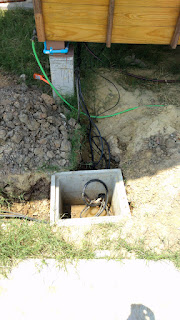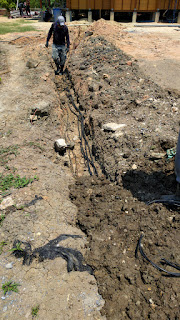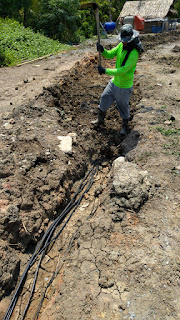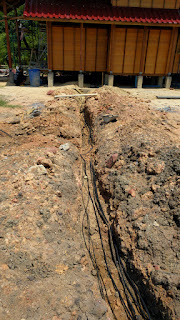I wrote recently about the biggest digging project we’ve had on the land that we used our home build excavator for. Since the trenching was completed, the next few steps turned out to be much more complicated than I had planned for.
Not difficult. Just complicated.
It starts with the story of the AC 220V mains electricity at BaanMae. I initially ran a 2 conductor underground wire to the house for the electricity, and grounded the main utility box on our land and BaanMae separately. As long as you bond neutral to ground at both places, this is okay. But more recent versions of the US electric code seem to want people to move away from this. By bonding ground to neutral at the “outbuilding” as well as at the main box, this creates a parallel pathway for electric return current to flow through. (Mostly it will flow through the low resistance neutral wire, but there is a higher resistance ground pathway in parallel that will take a smaller fraction of the current.) As a result, the ground wire will be taking some of the current, and if there happens to be a metal pipe in the ground running most of the way between the two ground wires, it could end up taking somewhat more. This isn’t what the grounding rods are supposed to be there for. And in addition, it means that detecting leakage between line and neutral (i.e. in a residual current circuit breaker) won’t work in the utility box since some of the current will normally “leak” to the ground pathway. (We can confirm this since the residual current detecting circuit breaker we installed in the main box kept triggering, so we needed to temporarily disable it.)
So, while I was trenching, I dropped in another ground wire so that the ground at the main utility box and the ground at BaanMae can be bonded together without having to bond neutral and ground at the BaanMae side. Removing the bond in the “outbuilding” means that the neutral current can’t flow through the ground. But the new ground wire makes sure that the ground at BaanMae and the ground at the main utility box are at the same potential.
In addition to the ground wire for BaanMae, the same network of trenches needs to run a 3 conductor AC 220V mains electricity line from the main utility box back to BaanRimNaam, telephone and CAT5 cable to BaanRimNaam for data and communications, a big fat 2 conductor cable between BaanRimNaam and BaanMae so that they can share the excess solar electricity they are generating, a smaller wire that runs between the two houses to power the walkway lights around the pond that needs to have a junction every 5 meters for the lights, a CAT5 cable for communications to turn on and off all of the lights, and power cables for the various circulation pumps that currently have their own solar panels (I would like to move these panels and batteries to the houses and have the circulation pumps share the electricity… this would reduce the amount of wastage).
At the same time, we ran some of the DC lines around BaanMae to power the DC water pump among others.
So it took a while to:
- design all of this and make sure I wasn’t missing anything (it will be quite a pain to lay new wire once the trench is closed up)
- buy all the wire needed in the correct sizes
- convey to the workers what goes where
- and then repeat all of the previous steps when I remembered what I was missing





